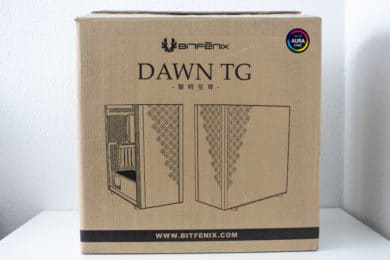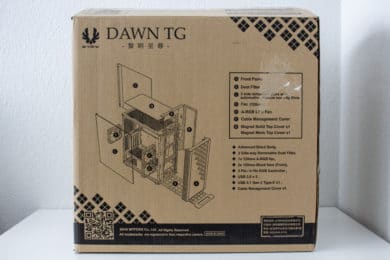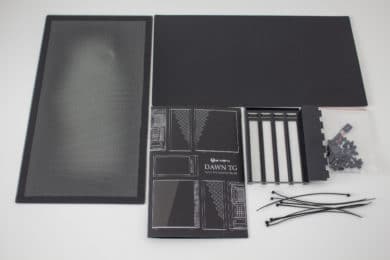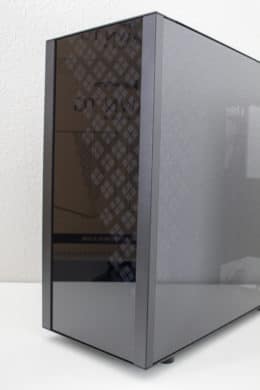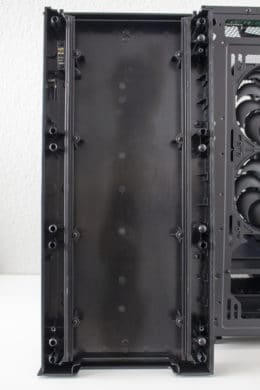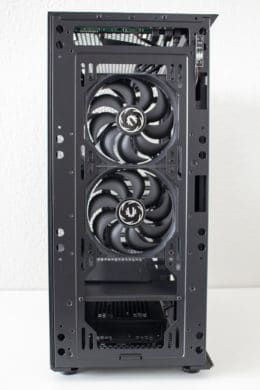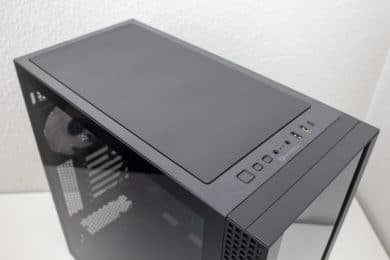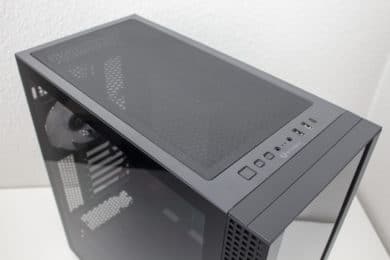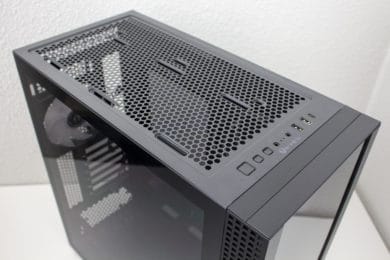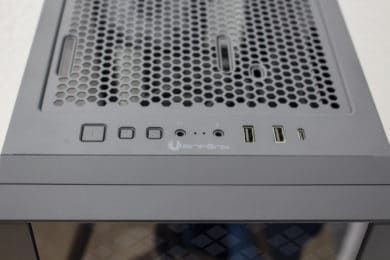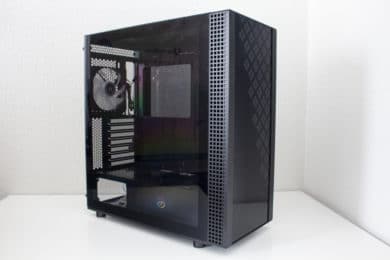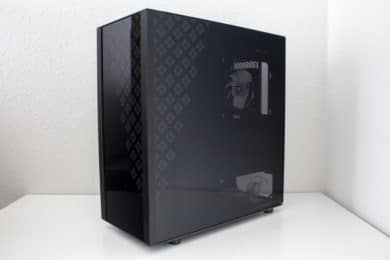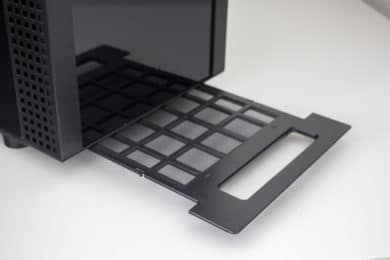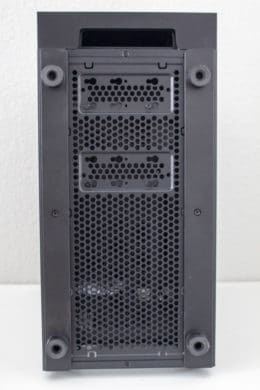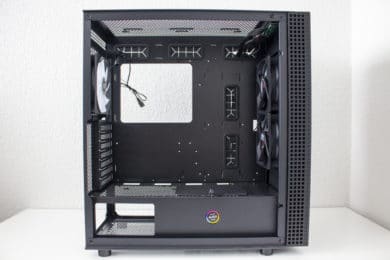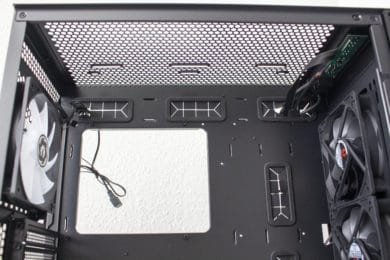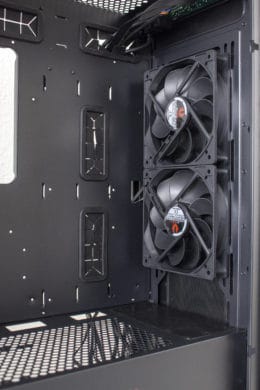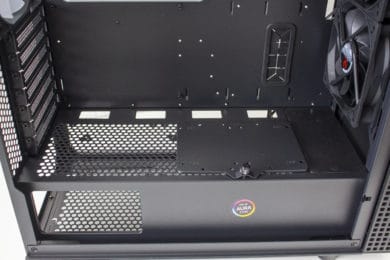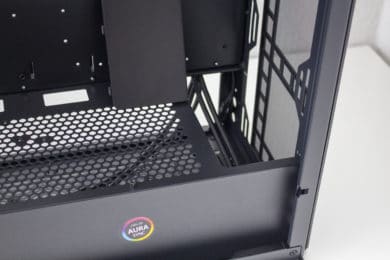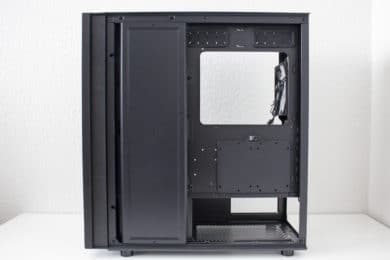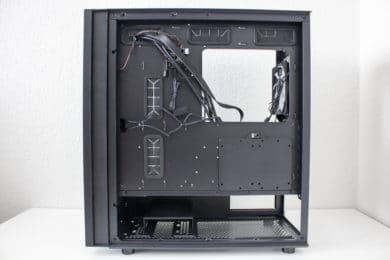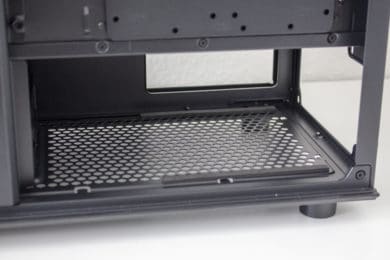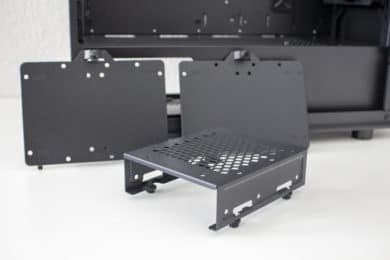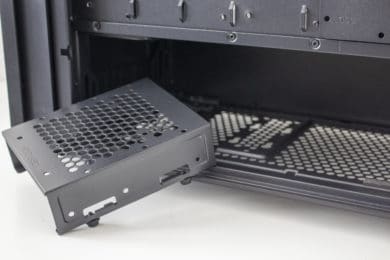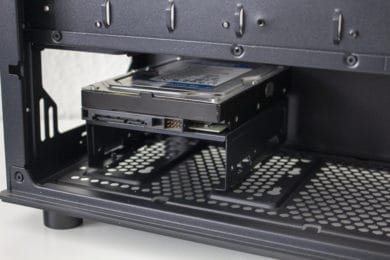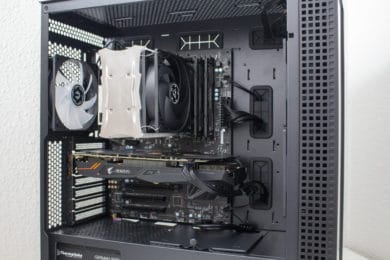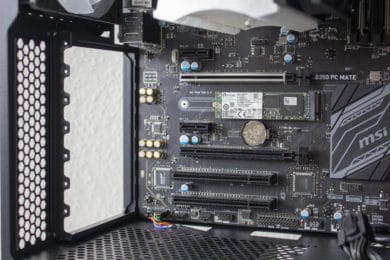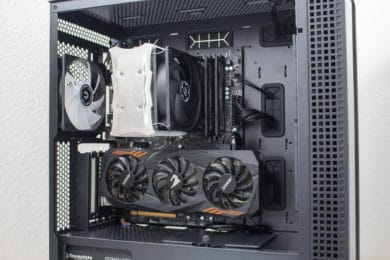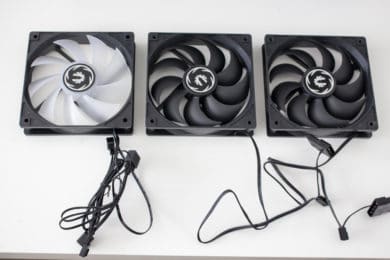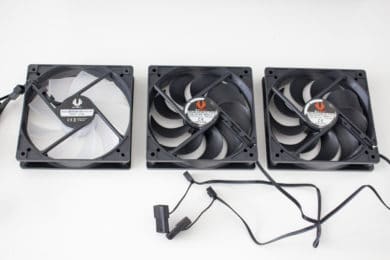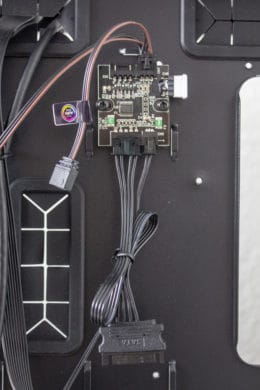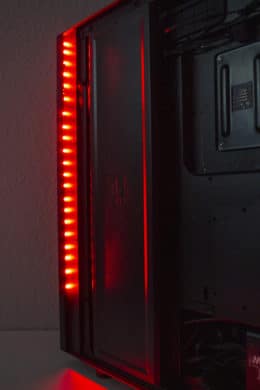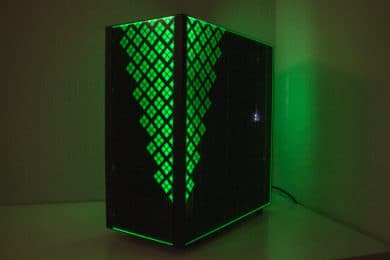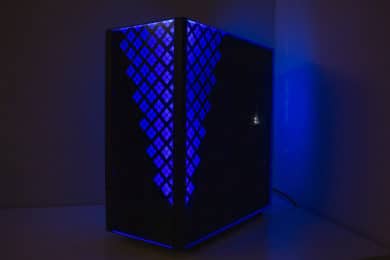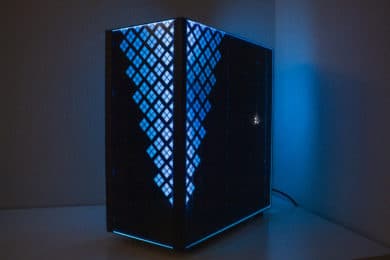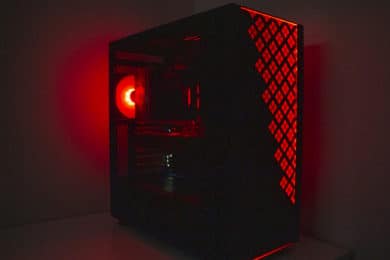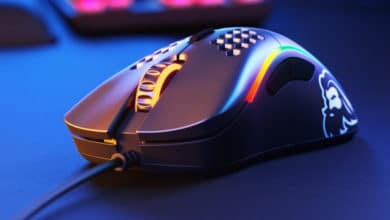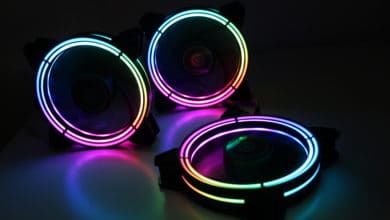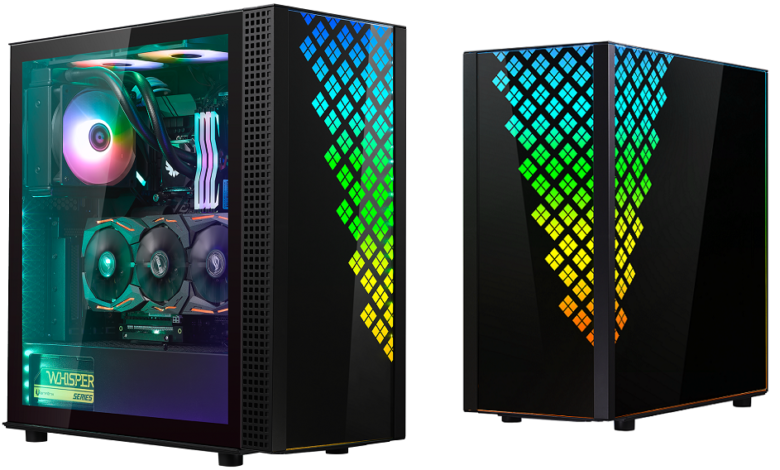
BitFenix enclosures have always stood for unique design. Although the company is still young, it has already secured a firm place in the PC case market. At Computex 2019, BitFenix showed another eye-catching case for the first time and officially announced it at the beginning of this year. The new midi tower is named Dawn TG and is supposed to convince especially optically by three glass elements and unique RGB effects. As further features BitFenix mentions a high hardware compatibility, USB Type-C on the front panel and a sophisticated cable management system.
Whether the € 124.86 * expensive BitFenix Dawn TG can convince us, you can find out in this review.
Technical details
| Model: | BitFenix Dawn TG |
| Case type: | Midi-Tower |
| Dimensions: | 220 mm (W) x 485 mm (H) x 449 mm (D) |
| Weight: | 9.87 kg |
| Material: | Steel, plastic, tempered glass |
| Color: | black |
| Front connectors | 1x USB 3.1 type-C, 2x USB 3.0 type-A, 1x speaker, 1x microphone |
| Drive bays: | 2x 3,5″/ 2,5″ (internal) 4x 2,5″ (internal) |
| Extension slots: | 7x horizontal |
| Form factors: | E-ATX, ATX, mATX, mini-ITX |
| Ventilation: | front: 3x 120 mm or 2x 140 mm Back side: 1x 120 mm bottom: 1x 120 mm Cover: 2x 120 / 140 mm |
| Radiators: | front: 1x 360 / 280 / 240 mm Rear: 1x 120 mm |
| Max. CPU cooler height: | 165 mm |
| Max. graphic card length: | 380 mm |
| Max. max. length of power supply unit: | up to 220 mm |
| Place for cable management: | up to 28 mm |
| Place for front radializer: | max. 65 mm depth, max. 141 mm width |
| Price: | € 124.86 * |
| Specials: | dust filter, cable management, glass side panels, RGB control |
Scope of delivery
The BitFenix Dawn TG comes well and safely packed in a brown box with black writing and is wrapped in two blocks of soft foam. On the box are pictures of the tower and all important technical data printed. All three glass elements are covered with a special protective film ex works which is normally used in the car industry. These must not be removed under any circumstances! The supplied accessories are in a bag and are fixed in the case with a cable tie. All important screws, an instruction manual, six black cable ties, a mainboard speaker and a cover with which the graphics card can be mounted vertically are included. In addition, three pre-installed 120 mm fans, pre-installed spacers and two exchangeable covers (1x Silent, 1x Mesh) for the lid are included in the scope of delivery. BitFenix is not afraid of rags when it comes to accessories.
Outside impression
Even when turned off, the BitFenix Dawn TG is already visually impressive. Especially the three glass elements on both sides and the front make this tower look very chic. The front panel consists of a sturdy plastic frame which encloses the glass element. Since there is also plastic behind the glass, you can’t see into the interior through this. In addition, a pattern of small squares was worked into the glass element. In order to ensure ventilation of the interior, the front has a large fan grille on the left side. In a case in this price range, a high-quality dust filter shouldn’t be missing, of course. This can simply be pulled out upwards in the BitFenix Dawn. If you remove the front panel with a strong jerk, you can also see two pre-installed case fans and the mounting rails for possible radiators.
The lid section is characterised by a large opening for fans and radiators. To give the buyer a choice, BitFenix includes two cover elements. Element one is a magnetic dust filter mat made of mesh. Element Two is probably intended to increase the Dawn TG’s silent factor, but looks more like a black sheet of paper to which magnetic stripes have been stuck. Also in the lid is the I/O panel. BitFenix can also stand out a bit from the competition here. There are two ports for USB 3.0 type-A, one port for USB 3.1 type-C with internal plug, two ports for headphones or microphone and three buttons for power, reset and RGB control.
As already mentioned in the introduction, both sides of the BitFenix Dawn TG are also made of tempered glass. But if you take a closer look, you will immediately see that the side parts are not completely identical. The left side part is slightly tinted and was glued to a steel frame. It is fixed with two knurled screws at the back of the Midi-Tower. To reduce vibrations, the frame also has thin rubber strips. The glass window on the right side is larger and has a similar pattern of squares as the front. To fix it, the window has to be slid into a narrow gap in the front panel and then screwed to the back with two knurled screws.
The back of the Bitfenix Dawn TG is designed in a way you would expect from a standard midi tower. The power supply unit is mounted in the lower area. Above it there are seven PCI slot panels which are mounted inside the tower and are reusable. Finally, there is the third pre-installed case fan at the back. This time even with RGB lighting. There are also no big surprises on the bottom side. The feet are made of plastic, appear stable and have thin rubber padding. In our case, however, these have left unsightly black marks on the table. Similar to the dust filter in the front, the filter for the power supply unit was also designed. It spans the entire underside and can easily be pulled out to the front.
Internal impression
The interior design of the BitFenix Dawn TG is based on the current standards of the case industry. The interior is basically divided into two chambers. The upper and very spacious chamber houses the mainboard, expansion cards and possible radiators. The two pre-installed fans in the front can supply the CPU and the GPU with cold air. The mainboard tray has been provided with five rubberized cable management openings and also has a cutout for mounting CPU coolers with backplate. Between the mounting points for the mainboard and the upper fan grill there is enough space for a radiator.
The power supply cover, located in the lower section, not only improves the appearance by covering the power supply, cables and hard drive cage, but also provides a perforation for better heat exchange between the chambers and additional cable management openings. In addition, the cover has a modular design. If you want to install a deep radiator in the front, the corresponding cover can be removed with two screws. Last but not least, there is a hard drive frame above the cover for two 2.5″ HDDs.
Now let’s take a look at the back. Since the left side panel of the BitFenix Dawn TG is also made of glass, the manufacturer has added an additional cover panel behind the mainboard tray. This is fastened with four conventional screws and is supposed to hide all connection cables and the HDD cage for 3.5″ HDDs from prying eyes. What isn’t covered, however, is the second mounting frame for SSDs and the power supply. This is installed, as usual, under the power supply cover and rests on narrow strips of rubber. Furthermore, there are still numerous mounting points for cable ties on the back.
One last point we need to mention here is the available capacity for data carriers. The BitFenix Dawn TG can accommodate a total of six data carriers. There are two frames with space for two 2.5″ SSDs each and a decoupled cage underneath the power supply cover for two 3.5″ or two 2.5″ hard disks. The frames or the cage can be mounted without tools. However, the actual mounting of the data carriers requires the use of screws and a screwdriver. The HDD cage can also be installed in two different positions.
System construction in the BitFenix Dawn TG
Now we come to the system installation. As hardware we use a AMD Ryzen 5 1400 on a MSI B350 PC Mate with 32 GB Crucial Ballistix Sport LT grey DDR4-3000. The Ryzen is cooled by an EKL Alpenföhn Matterhorn Pure. For the image output a GTX 1060 6GB from Gigabte AORUS is responsible. The power supply does the non-modular Berlin Pro RGB 650W with RGB fan.
There is one thing that the BitFenix Dawn TG has plenty of: plenty of space. This has made the installation of all components very easy. The system was quickly installed and wired. Besides the space, the pre-installed spacers, the power supply cover and the cable cover on the back of the mainboard tray also contributed to the chic and tidy end result. However, there was a bit of frustration. Thus, the cable cover is only attached with four normal screws. If there are also cables underneath, the reattachment is a bit tricky. Knurled screws would definitely have been helpful here.
There are no real limitations with regard to general hardware compatibility. Graphics cards are supported up to a maximum length of 380 millimetres and CPU coolers up to a maximum height of 165 millimetres. This is sufficient for all current GPUs and for many CPU coolers. It is also spacious under the power supply cover. If you need the HDD cage, you can still install a 220 millimeter long power supply. If you prefer to use a water cooling, the BitFenix Dawn also offers enough space for this. A 360 and a 240 millimeter long radiator can be easily accommodated in the interior.
Another special feature is the included PCI bezel, which allows a graphic card to be mounted vertically without the fans being directly on the side panel. To do this, you only have to remove the seven PCI slot bezels, attach the graphics card to the mounting frame and reinstall the bezel. However, a PCI riser cable is not included in the scope of delivery and must be purchased separately.
BitFenix equips the Dawn TG with three pre-installed fans ex works. One of these fans is RGB capable, the other two are simply black. For power supply, all fans have a normal 3-pin connector. However, the RGB fan was additionally equipped with a Y-junction and can be controlled by the mainboard via a 5V-ARGB connector. The maximum speed of the RGB fan is 1400 revolutions per minute. The two front fans on the other hand rotate with a maximum of 1000 rpm. At full speed the fans can be clearly heard out of the system, but don’t look unpleasant yet.
Finally we come to the temperatures reached in the BitFenix Dawn TG. During the load test, Prime95 and FurMark were run at a room temperature of 21°C for 15 minutes. Additionally, this test was performed in four different variants (case fan on 100% with open and closed lid, case fan on 50% with open and closed lid).
scenario |
temperature |
| CPU: 50% PWM (1100 rpm) GPU: 50% PWM (1650 rpm) Case: 12V (1400 rpm, 1000 rpm) Cover closed |
CPU: 74 °C GPU: 70 °C |
| CPU: 50% (1100 rpm) GPU: 50% PWM (1650 rpm) Case: 7V (1000 rpm, 700 rpm) Cover closed |
CPU: 78 °C GPU: 72 °C |
| CPU: 50% PWM (1100 rpm) GPU: 50% PWM (1650 rpm) Case: 12V (1400 rpm, 700 rpm) Cover open |
CPU: 74 °C GPU: 70 °C |
| CPU: 50% PWM (1100 rpm) GPU: 50% PWM (1650 rpm) Case: 7V (1000 rpm, 800 rpm) Cover open |
CPU: 75 °C GPU: 72 °C |
After the measurements, it turns out that the hardware in the BitFenix Dawn TG does get quite warm. Of course, the CPU is overclocked, but if you take the noise into account, the temperatures seem a bit high despite the three pre-installed fans. It’s also strange that at full speed the case fan doesn’t make a difference whether the lid is open or closed. That’s why we made a fifth measurement. For this measurement, we completely removed the front panel and left the lid open.
Scenario |
Temperature |
| CPU: 50% PWM (1100 rpm) GPU: 50% PWM (1650 rpm) Case: 12V (1400 rpm, 1200 rpm) Cover open without front panel |
CPU: 62 °C GPU: 63 °C |
The measurement clearly shows that the front panel significantly reduces the possible airflow. Without front panel, the fans get much more air and can cool the components better. The processor is 12 degrees cooler, the graphic card 7 degrees after all.
Lighting options in the BitFenix Dawn TG
As can be easily seen on the power supply cover, the BitFenix Dawn TG’s RGB lighting is compatible with Asus’ Aura Sync technology. All RGB elements are digitally addressable and can be controlled via a mainboard with the appropriate connectors. To do this, the board on the back must be connected directly to the RGB header on the mainboard. The only built-in RGB fan can also be connected to the board. If you still use a mainboard without the appropriate RGB headers, the lighting can also be controlled via the pre-installed board. For this purpose, the board only needs to be supplied with power via SATA power connector. The switching of the stored color combinations is then done via the button on the I/O panel.
BitFenix has once again come up with something special for the lighting. In the chapter exterior impression we already mentioned that two of the three panes were provided with a pattern of squares. These squares are the main part of the lighting. However, the pattern is not direct but only indirectly illuminated. Therefore, there are two digitally addressable LED strips hidden in the front panel that illuminate the panes or the pattern. This constellation creates an impressive play of colours on the tempered glass. Below are some more impressions of the lighting.
Conclusion on the BitFenix Dawn TG
Let us now come to a final conclusion. With the Dawn TG, BitFenix has once again succeeded in designing an innovative case that puts a whole new focus on RGB lighting. This is achieved by a special design of the three glass windows and a sensible positioning of the RGB strips. Besides the chic RGB effects, this Midi-Tower can convince with many more features. The Dawn TG is very well manufactured, offers a lot of space for hardware and has a well thought-out cable management system. Further features such as the USB type-C port in the I/O panel, the included bracket for vertical GPU mounting, as well as the three pre-installed fans round off the overall package in a sensible way.
But there were also two points we had to criticize. For example, the achieved temperature values are not optimal and drop significantly when the front panel is removed. This speaks for the fact that the front element is designed too restrictive due to the only one-sided fan grills. The buyer doesn’t have to be afraid of temperature-related crashes, though. Moreover, you always need a screwdriver to mount the data carriers and decoupling is only given for the large HDD cage.
If we now compare the positive and negative points and include the price of € 124.86 in the evaluation, we can give a clear recommendation to buy the BitFenix Dawn TG.
BitFenix Dawn TG
Workmanship
Structure
Features
Cooling
Value for money
90/100
The BitFenix Dawn TG convinces with a good workmanship as well as equipment, lots of glass and an innovative RGB lighting. But shows slight weaknesses in the airflow.
